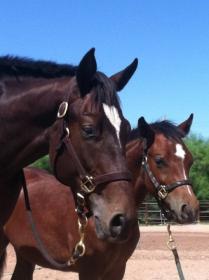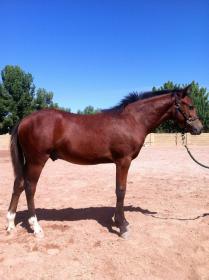[QUOTE=arlosmine;7330786]
It’s much less predictable to breed extremes in type and size to one another. Rather than a blend of the two, you can get “Frankenpony”: horses head, pony legs, horse body, pony feet.
I have three warmblood X Pony crosses:
One is a Haflinger X Hanovarian. Han sire was about 16.2, Haffy mom was around 13.3. My guy is 14.2 and weighs 1000lb. His head is the same size as my 16.2 hand cob cross. (thank god it’s a cute head!) he has a longish, stout body on short legs. He is rather oddly proportioned, but correct work has muscled him in the right places, and he no longer looks like he is going to tip over and land on his nose. He has lovely big bone and big hard feet. BEST BRAIN EVER. He moves like a pony until you get him through his back, then he is much improved. He is the best school horse in the world since I can put tiny children and larger adults on him. He is fantastically trainable: not a world beater athlete, but I have made a personal project out of him because he is tries so hard. I will show him second level this year.
I also have a coming three year old Wesser Ems gelding. Fancy! His dam is a 12.2 hand section B welsh pony. Dad is DSF Farscape, a 16.2 hand Westfalen. yesterday I measured “Fig” and he is 14.1/2" at the wither. Right now he is level and looks almost ready to back. The string test says 14.2…but we will see. I may have a hony on my hands in a few years, but since my sport of choice is dressage, I opted to risk getting a little oversize, rather than under. If he goes “over” my back-up plan as marketing him as a hunter pony goes up in smoke. I have to wait until he’s six and gets a permanent card before I could ask real money for him in the hunter market, since he’s an F-1 cross and could well have a late growth spurt.
He is a more harmonious blend of horse and pony parts. He looks and moves like a small horse, with really good horse gaits. His walk, in particular is very nice…an 8 at least (let’s hope it stays that way with a rider on him!) His temperament is fantastic.
Finally, I have a Cob X TB cross. Mom was a 16 hand TB, dad a 14 hand Cob. This guy’s hocks, head, knees and feet were all so big when he was a yearling that he looked like a great Dane puppy. He was down hill forever. When he finally leveled out at five I thought he was done growing at 16 hands. Then he grew another 2 inches between his fifth and seventh years. I researched both parent’s ancestors, and found that the mare had two full brothers over 17 hands. The sire had some of the very tall Cobs a few generations back in his pedigree. All the latent “tall genes” in mom and dad got together for my guy. He has been a wonderful horse. We evented, showed in open dressage, went horse camping…you name it. Another stellar temperament.
So: it is a crap shoot! If you are needing a specific size, you are not likely to get exactly what you want. If you would breed your mare regardless of size, go ahead. I would look at the size behind the mare, and for sure breed her to a stallion with lots of babies on the ground to get an idea of what he throws.
Then there is the possibility of a frankenhorse… I love my Haffy cross, but if I was trying to breed for a horse for myself, I would have failed.
Good luck! Pony crosses are delightful :)[/QUOTE]
As the breeder of Fig…here are some thoughts…my pony mare, his mom LOOKS like a small horse…she has the pony ears and ‘bunny’ tail of a Welsh B but otherwise, she looks like a very good small horse. Her neck is long, he hip is longish and she is refined like a small T/B or Anglo Arab. So, she is phenotypically “Typey” like a horse. The stallion we bred her too is also “Typey” and not a big warmblood horse but just proportionatly like the pony mother. I do think height is a multi-gene characteristic. Some of height is in the lower legs, some in the upper leg and a lot in the body and wither…so a low withered horse/pony may be shorter than the exact same horse/pony with tall withers which are just fingerlike projections of the spine…A soft pasterned equine will be shorter than the same one with straight pasterns. So, the article is correct but way over simplified in my mind on all the variables that affect genetically affect height. Breeding a T/B to a really ‘cobby’ or draft pony type pony is not only a height difference it is also a huge type difference. Is the horse being bred tall because it has long upright pasterns, a long cannon, straight shoulder and very high wither…??? If this horse was bred to a shorter one that has a short and sloping pastern, short cannons, laid back shoulder and low wither…well you can see where I am going here. I think height is created by many variables. If you breedy a horse looking but shorter pony to a horse that is typey…you probably wont get ‘fankenpony’. All breeding is a bit of a crap shoot. But, those who are dedicated to doing it well have fewer big ‘ooopsies’. The mare I bred for Fig has had 3 foals, 2 by horses and one by a typey cob and all look like small horses, large ponies and all so far are maturing at around half way between the parents…so go “Fig” ure…


